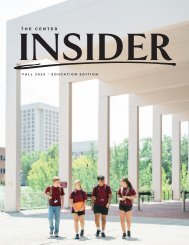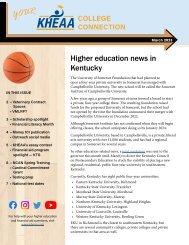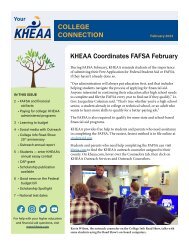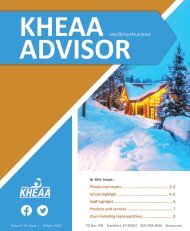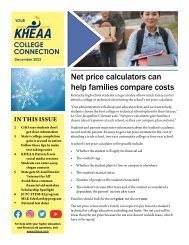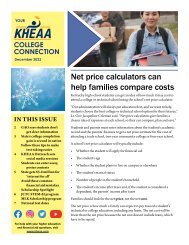YKCC August 2022
Create successful ePaper yourself
Turn your PDF publications into a flip-book with our unique Google optimized e-Paper software.
YOUR<br />
COLLEGE<br />
CONNECTION<br />
<strong>August</strong> <strong>2022</strong><br />
IN THIS ISSUE<br />
2 Pay attention to financial<br />
aid deadlines<br />
College graduation rates<br />
increase in Kentucky<br />
3 Understand satisfactory<br />
academic progress<br />
Earning college credit in<br />
high school<br />
4 Grants will provide more<br />
health care training<br />
Social media schedule<br />
5 Truths and myths about<br />
private student loans<br />
6 High school planners<br />
Scholarship Spotlight<br />
7 National test dates<br />
For help with your higher education<br />
and financial aid questions, visit<br />
www.kheaa.com<br />
Pilot scholarship program<br />
will help displaced students<br />
A pilot scholarship program will help students who have come to Kentucky<br />
because of crises in their home countries. The scholarships are funded by a<br />
$10 million appropriation by the General Assembly.<br />
The Innovative Scholarship Pilot Program will help students who have<br />
received or applied for asylum in the U.S. or who meet other criteria.<br />
“Making Kentucky a welcoming place for people who have been displaced<br />
by a crisis in their home country is important,” Gov. Andy Beshear said.<br />
“These new humanitarian scholarships will go a long way in helping them<br />
further their education and contribute to our communities and economy.<br />
I’m proud of our great colleges and universities for participating in this<br />
worthwhile program.”<br />
The program also provides scholarships for native Kentuckians attending instate<br />
colleges to study in other nations.<br />
“This scholarship program will give displaced students the chance to earn<br />
a degree at one of our outstanding colleges and universities and go on to<br />
use those skills to contribute to our state’s economy,” said Kentucky Senate<br />
President Robert Stivers. “Kentucky students will also have the opportunity<br />
to study internationally. Helping students gain those learning experiences<br />
will help strengthen our workforce.”<br />
The scholarship is jointly administered by KHEAA and the Kentucky<br />
Council on Postsecondary Education.<br />
Funds for the Kentucky Humanitarian Assistance Scholarships and<br />
Kentucky Scholarships for Cultural Exchange will be distributed to<br />
campuses by KHEAA starting this summer. They are available to both<br />
public and private, nonprofit Kentucky higher education institutions.<br />
Campuses are required to provide a 25 percent match to receive the grants.<br />
As part of the program, CPE will provide support for college and university<br />
staff who recruit, advise and support students from displaced populations.
2<br />
Pay attention to deadlines<br />
for student financial aid<br />
Students should keep a close eye on deadlines when<br />
applying for student financial aid,<br />
“As Kentucky students make their plans for beginning or<br />
continuing their postsecondary education, they should<br />
try to get all the financial aid they can,” said Lt. Gov.<br />
Jacqueline Coleman. “To make sure they do so, they need<br />
to apply for that aid on a timely basis. Every scholarship<br />
or grant they receive will reduce their dependence on<br />
student loans.”<br />
Here are some helpful student financial aid tips from<br />
KHEAA:<br />
• File the Free Application for Federal Student Aid<br />
(FAFSA) as soon as possible beginning Oct. 1. You<br />
must submit the FAFSA to qualify for most state and<br />
federal student aid.<br />
• Check with the financial aid offices of the schools to<br />
which you’ve applied to determine if they require any<br />
forms other than the FAFSA.<br />
• Look for scholarships using KHEAA’s Affording<br />
Higher Education and a free online scholarship<br />
search. You can find a link to a free search site under<br />
the “Paying for College” tab on kheaa.com.<br />
• Attend any college fairs and financial aid seminars<br />
offered in your area. If a company charges a fee for<br />
helping with applications, remember that you can do<br />
that yourself for free. If you decide to pay for help,<br />
make sure the company is reputable by checking with<br />
the attorney general’s office or the Better Business<br />
Bureau in your area, as well as the area where the firm<br />
is located.<br />
College grad rates increase<br />
as number enrolled drops<br />
College graduation rates are on the rise in Kentucky<br />
despite a drop in enrollment, according to a report from<br />
the Kentucky Council on Postsecondary Education. The<br />
report covers the 2020–21 school year.<br />
The report showed graduation rates increased 1.8 percent<br />
at public universities and 4.1 percent at Kentucky<br />
Community and Technical College System schools.<br />
Graduation rates show the percentage of first-time, fulltime<br />
students who start school in the fall semester and<br />
earn an associate’s degree or credential within three years<br />
or a bachelor’s degree within six years.<br />
Underrepresented minority (URM) students showed the<br />
biggest gains. The enrollment of URM students jumped<br />
14.1 percent, while overall enrollment dropped by 6.9<br />
percent. The number of degrees and credentials earned<br />
by URM students increased by 41.3 percent, more than<br />
double the overall 17.8 percent rise.<br />
The number of graduate degrees awarded increased by<br />
7.1 percent. State funding per full-time student increased<br />
10.6 percent over 2019–20, the largest single year<br />
increase in several decades.<br />
The complete report can be accessed on cpe.ky.gov.
Earn college credit in high<br />
school to save money later<br />
One way for students to save money on the cost of higher<br />
education is to earn college credits while they’re still in<br />
high school.<br />
Be sure you understand<br />
school’s SAP standards<br />
One important phrase in the language of student aid is<br />
satisfactory academic progress, or SAP.<br />
All colleges that award federal student aid must have SAP<br />
standards. Each school can define what it will consider<br />
SAP, but federal law requires that definition to include<br />
three things: GPA, pace and maximum time frame.<br />
The GPA you’re required to have may vary by school,<br />
major and whether you’re an undergraduate or graduate<br />
student. Some schools may include your GPAs from<br />
other schools you’ve attended, some won’t.<br />
Your pace means that you have to pass a stated<br />
percentage of the classes you take in a given period of<br />
time. It may also vary by college.<br />
The maximum time frame means you’ll have to finish<br />
your degree within a given number of attempted credit<br />
hours. Let’s say that your school requires you to pass 120<br />
credit hours to earn a bachelor’s degree. The maximum<br />
time frame might be that you have to pass those 120<br />
hours without attempting more than 150 hours.<br />
The catch is: if you don’t meet your school’s SAP<br />
standards, you may not be able to receive state or federal<br />
student aid. Make sure you know what your college’s<br />
standards are before you get in trouble.<br />
“I urge Kentucky students to take advantage of programs<br />
that let them earn credits for college and technical<br />
programs while they are still in high school,” Lt. Gov.<br />
Jacqueline Coleman said. “If they do, they may be able<br />
to graduate not only with a high school diploma but<br />
also a technical credential or even a two-year associate’s<br />
degree.”<br />
High school students can take advantage of several<br />
programs that let them earn college credits. These<br />
programs include:<br />
• Dual credit courses. These courses let students<br />
earn both college and high school credit. They are<br />
offered in both academic and technical areas. In<br />
some cases, students will pay less than the college<br />
tuition rate. KHEAA administers the state’s dual<br />
credit scholarship programs, which can be used at<br />
participating public and private universities and<br />
colleges.<br />
• Advanced Placement (AP) courses. AP classes<br />
count as high school credits, but many colleges will<br />
give students college credit if they earn a certain<br />
grade on AP exams. Offered by the College Board,<br />
AP classes are widely available.<br />
• International Baccalaureate (IB) Diploma and<br />
Cambridge Advanced International (CAI)<br />
programs. IB and CAI are for students 16 to 19<br />
years old and are similar to AP courses. High school<br />
students may be able to receive college credit for the<br />
IB and CAI classes they take.<br />
Your school will check to see if you’re meeting its SAP<br />
requirements. If you’re not, the school will let you know.<br />
It will also tell you about the appeal process all schools<br />
must have.<br />
3
4<br />
Grants will help address<br />
health care shortage<br />
Kentucky’s public 2- and 4-year colleges and universities<br />
have received $8 million in grants to help address the<br />
shortage of health care workers.<br />
The grants, funded by the General Assembly, will help<br />
colleges expand programs to get more front-line health<br />
care workers trained and on the job. The grants were<br />
made by the Kentucky Council on Postsecondary<br />
Education’s Healthcare Workforce Collaborative.<br />
The grants will be used to develop and expand clinical<br />
learning programs by:<br />
• Developing courses and increasing enrollment.<br />
• Providing supplemental learning.<br />
• Recruiting and retaining faculty.<br />
• Expanding advising and outreach efforts.<br />
• Adopting up-to-date technology.<br />
• Providing work experiences during training.<br />
• Targeting rural regions to develop training programs.<br />
Strategies include offering flexible evening and weekend<br />
courses, awarding college credit to high school students<br />
who complete summer programs, sharing staff between<br />
health care facilities and colleges, and more.<br />
The funds will also be used to recruit and retain<br />
underrepresented minority students. In Kentucky, about<br />
4% of nurses are Black and about 1% are Hispanic.<br />
The plans focus largely on nursing programs due to<br />
the nursing shortage crisis in the state. According to<br />
state officials, Kentucky is projected to need 16,000<br />
more nurses by 2024. Training for other front-line<br />
professionals — including physicians, physician<br />
assistants, physical therapists, mental health practitioners<br />
and medical social workers — was also included in the<br />
plans.<br />
KHEAA Outreach schedules<br />
Facebook, Twitter sessions<br />
KHEAA Outreach will provide live help this fall<br />
semester via Facebook, Twitter and YouTube.<br />
The schedule is:<br />
Sept. 12: Life Hack: Planning and Preparing for College,<br />
Facebook<br />
Sept. 19: Life Hack: Exploring Admissions, Twitter<br />
Oct. 3: No Tricks ... Just Treats: Completing the FAFSA,<br />
Facebook<br />
Oct. 10: FAFSA Completion Walk Through, Webinar<br />
Oct. 17: No Tricks ... Just Treats: FAFSA Tips, Twitter<br />
Nov. 7: Gifts That Keep on Giving: Financial Aid<br />
Opportunities, Facebook<br />
Nov. 14: Gifts That Keep on Giving: KY Saves 529,<br />
Twitter<br />
Dec. 5: Santa’s Nice List: Advantage Loans, Facebook<br />
Dec. 12: Santa’s Nice List: Loan Borrowing Tips, Twitter<br />
All sessions begin at 7 p.m. Eastern, 6 p.m. Central.<br />
The links are:<br />
www.facebook.com/KHEAA/<br />
www.twitter.com/KHEAA/
Truths, myths about private student loans<br />
CHESTER PRIEST<br />
Borrowing money for<br />
college can seem confusing<br />
with the various federal<br />
and private student loan<br />
options, borrowing limits<br />
and interest rates.<br />
Once you deduct your<br />
scholarships and grants<br />
from your cost of<br />
attendance, loans can help<br />
close the college cost gap.<br />
If you’re an undergraduate<br />
student, a Federal Direct<br />
Loan is your best bet.<br />
CHESTER PRIEST<br />
Federal student loans are made by the U.S. Department<br />
of Education. There are several advantages to federal<br />
loans that aren’t generally available with private loans:<br />
deferment and forbearance options, income-based<br />
repayment and loan forgiveness plans.<br />
When your grants, scholarships, work-study and federal<br />
loans don’t cover your school costs, private loans can<br />
cover the rest of the cost of your education. Banks, credit<br />
unions or independent public agencies offer private<br />
student loans to help pay for college expenses. You can<br />
find information on private loans online, but some sites<br />
don’t give the whole picture. Let’s dispel some common<br />
myths about private loans:<br />
Myth 1: If I take out a loan, I’ll be in debt forever.<br />
It may seem that way, but ten years is the standard<br />
repayment plan. If your circumstances change, contact<br />
your loan servicer for help before your loans go into<br />
default. Defaulting on your student loans can harm your<br />
financial future. Your servicer can usually find a way to<br />
keep that from happening.<br />
Myth 2: Private loans are more expensive and charge<br />
more fees. This is where good research comes into play.<br />
Private loan interest rates can be less than federal student<br />
loans, so check out several lenders. Also, pay attention<br />
to any fees, such as an origination fees, that are charged.<br />
Some lenders don’t charge origination fees, so you’ll<br />
get all the money you borrow. The U.S. Department of<br />
Education always charges an origination fee on Federal<br />
Direct and Federal PLUS Loans.<br />
Myth 3: If you need a cosigner, they are on the hook<br />
for the life of the loan. Most lenders let cosigners ask for<br />
a release after you make your payments on time for 12 to<br />
48 months.<br />
Myth 4: You can borrow too much and land in deeper<br />
debt. Unlike federal loans, private loans are credit- and<br />
income-based, so you’ll only be able to borrow as much as<br />
you can reasonably afford to repay.<br />
Myth 5: Private lenders won’t help borrowers who<br />
have repayment trouble. It’s good business practice<br />
to help your customers, so lenders will work with you if<br />
you’re having troubles. When choosing a private lender,<br />
be sure to investigate their policies regarding postponing<br />
payments.<br />
Parents, graduate students and professional students with<br />
good credit or a cosigner may be able to get much lower<br />
interest rates on private loans than on Federal PLUS<br />
Loans.<br />
If you’ll need private loans to help pay for college, be an<br />
informed consumer. Many colleges have an online list of<br />
private lenders the school works with.<br />
Chester Priest is business development manager<br />
for the Kentucky Higher Education Student Loan<br />
Corporation.<br />
5
6<br />
High school planners<br />
Freshmen<br />
□<br />
□<br />
□<br />
□<br />
□<br />
Sophomores<br />
□<br />
□<br />
□<br />
□<br />
□<br />
Develop good study habits.<br />
If you attend a public Kentucky high school, take the<br />
time to become familiar with your ILP.<br />
Juniors<br />
□<br />
□<br />
□<br />
□<br />
Make good grades.<br />
Make sure you understand how the KEES program<br />
works.<br />
Set up an account on kheaa.com.<br />
Talk with your counselor about AP, other advanced<br />
classes and dual credit courses.<br />
If you attend a public Kentucky high school, check<br />
your ILP to make sure you’re on track.<br />
Check your KEES account to make sure the<br />
information is correct.<br />
Make a list of colleges that interest you.<br />
Consider taking the PSAT as a prep for your junior<br />
year, when it counts.<br />
Talk with your school counselor about your options<br />
and plans.<br />
Develop a list of colleges you’re interested in. Check<br />
out Getting In, a KHEAA publication that lists<br />
Kentucky colleges and universities.<br />
Ask for a preview of your academic record and<br />
profile. Talk with your counselor on how you can get<br />
accepted to the school of your choice.<br />
Begin planning college visits. Try to time your visit<br />
so you can see classes going on.<br />
Seniors<br />
□<br />
□<br />
□<br />
□<br />
Ask colleges you’re interested in to send you<br />
admissions information.<br />
If you’re applying for Early Decision, start filling out<br />
the forms to meet the deadline.<br />
If you haven’t taken the ACT/SAT or if you think you<br />
can do better, take it again.<br />
Get with your counselor to find out about the<br />
financial sources available to you. Use KHEAA’s<br />
Affording Higher Education. A new edition will<br />
be available this fall. You can also use the free<br />
scholarship search link on kheaa.com.<br />
Scholarship Spotlight<br />
Kentucky Association of Fairs<br />
and Horse Shows Youth Scholarship<br />
Eligibility: Must have participated in any approved<br />
agricultural class; have been an active volunteer the<br />
current year at their local county fair; be recommended<br />
by their local fair; be a high school senior or a firstyear<br />
postsecondary school student; be under age 21<br />
as of October 1 of the application year; be a resident<br />
of the county of the nominating fair; and submit an<br />
application, a 1-page letter of recommendation from<br />
the local fair board and an essay of up to 500 words<br />
on the topic “Describe how your personal life skills<br />
have been enhanced by your involvement in your local<br />
fair activities.” The recipient should attend the annual<br />
business meeting in January to receive the scholarship.<br />
Award: $1,500; nonrenewable<br />
Number: 6<br />
Deadline: October 1<br />
Contact: Mike Poynter, 105 Sunset Drive, Hustonville,<br />
KY 40437; m_poynter@yahoo.com; www.kafs.net
ACT National Test Dates<br />
Test Date Registration Deadline Late Registration<br />
Oct. 22, <strong>2022</strong> Sept. 16, <strong>2022</strong> Sept. 30, <strong>2022</strong><br />
Dec. 10, <strong>2022</strong> Nov. 4, <strong>2022</strong> Nov. 11, <strong>2022</strong><br />
Feb. 11, 2023 Jan. 6, 2023 Jan. 20, 2023<br />
April 15, 2023 March 10, 2023 March 24, 2023<br />
June 10, 2023 May 5, 2023 May 19, 2023<br />
July 15, 2023 June 16, 2023 June 23, 2023<br />
SAT National Test Dates<br />
Oct. 1, <strong>2022</strong> Sept. 2, <strong>2022</strong> Sept. 20, <strong>2022</strong><br />
Nov. 5, <strong>2022</strong> Oct. 7, <strong>2022</strong> Oct. 10, <strong>2022</strong><br />
Dec. 3, <strong>2022</strong> Nov. 3, <strong>2022</strong> Nov. 22, <strong>2022</strong><br />
March 11, 2023 Feb. 10, 2023 Feb. 28, 2023<br />
May 6, 2023 April 7, 2023 April 25, 2023<br />
June 3, 2023 May 4, 2023 May 23, 2023<br />
DREAMS don’t just<br />
come true. They’re<br />
MADE true.<br />
Invest in your child’s dreams for the future.<br />
Open a KY Saves 529 account now.<br />
7




